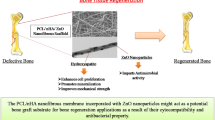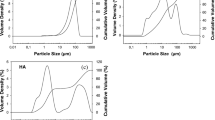Abstract
Combination of bioceramics with polymers to fabricate nanofibrous scaffolds holds enormous potential for bone tissue regeneration. In this study, we aim to incorporate HAp nanoparticles in trace do** amount in PVA-chitosan nanofiber matrix to fabricate PVA-chitosan composite nanofibers with improved performance for application as a bone tissue regeneration material. The diameter of the fabricated composite nanofibrous mat is estimated as 300 ± 121 nm. Beads free nanofibers mat with uniform morphology was ascertained for all sample groups by scanning electron microscopy (SEM) and the overall composition was assessed using Fourier transform infrared spectroscopy (FTIR) and energy dispersive X-ray spectroscopy (EDX). SEM images showed a homogeneous distribution of HAp nanoparticles in the composite nanofibers matrix. Further, X-ray diffraction (XRD) was performed to determine the crystallinity of the fabricated scaffolds. Swelling behavior and hydrolytic degradation of nanofibrous mats were subsequently evaluated by immersing in PBS buffer at pH 7.4 at physiological temperature (37 °C). The biocompatibility study of nanofiber scaffolds was performed with MC3T3 cells. Significantly higher cellular viability was observed on HAp nanoparticles incorporated composite nanofibrous scaffold surface after 7 days of culture in comparison to scaffolds without HAp.




Similar content being viewed by others
References
Baroli B (2009) From natural bone grafts to tissue engineering therapeutics: brainstorming on pharmaceutical formulative requirements and challenges. J Pharm Sci 98:1317–1375
Dimitriou R, Jones E, McGonagle D (2011) Bone regeneration: current concepts and future directions. BMC Med. 9:66
Soucacos PN, Johnson EO, Babis G (2008) An update on recent advances in bone regeneration. Injury 39S2:S1–S4
Basu B (2017) Biomaterials science and tissue engineering, principles and methods. Cambridge University Press, Cambridge
Bodhak S, Kikuchi M, Sogo Y, Tsurushima H, Ito A, Oyane A (2013) Calcium phosphate coating on a bioresorbable hydroxyapatite/collagen nanocomposite for surface functionalization. Chem Lett 42:1029–1031
Bodhak S, De Castro LF, Kuznetsov SA, Azusa M, Bonfim D, Robey PG Jr, Simon CG (2018) Combinatorial cassettes to systematically evaluate tissue-engineered constructs in recipient mice. Biomaterials 186:31–43
Guerado E, Caso E (2017) Challenges of bone tissue engineering in orthopaedic patients. World J Orthop 8:87–98
Turnbull G, Clarke J, Picard F, Riches P, Jia L, Han F, Li B, Shu W (2018) 3D bioactive composite scaffolds for bone tissue engineering. Bioact Mater 3:278–314
Ghassemi T, Shahroodi A, Ebrahimzadeh MH, Mousavian A, Movaffagh J, Moradi A (2018) Current concepts in scaffolding for bone tissue engineering. Arch Bone Jt Surg 6:90–99
Chen D, Sarkar S, Candia J, Florczyk SJ, Bodhak S, Driscoll MK Jr, Simon CG, Dunkers JP, Losert W (2016) Machine learning based methodology to identify cell shape phenotypes associated with microenvironmental cues. Biomaterials 104:104–118
Jun I, Han HS, Edwards JR, Jeon H (2018) Electrospun fibrous scaffolds for tissue engineering: viewpoints on architecture and fabrication. Int J Mol Sci 19:E745
Khorshidi S, Mirzadeh A, Mazinani S, Lagaron JM, Sharifi S, Ramakrishna S (2016) A review of key challenges of electrospun scaffolds for tissue-engineering applications. J Tissue Eng Regen Med 10:715–738
Levengood SL, Zhang M (2014) Chitosan-based scaffolds for bone tissue engineering. J Mater Chem B 2:3161–3184
Kim SB, Kim YJ, Yoon TL, Park SA, Cho IH, Kim EJ, Kim IA, Shin JW (2004) The characteristics of a hydroxyapatite-chitosan-PMMA bone cement. Biomaterials 25:5715–5723
Kim SE, Cho YW, Chung H, Jeong SY, Kwon ICL (2003) Porous chitosan scaffold containing microspheres loaded with transforming growth factor-beta1: implications for cartilage tissue engineering. J Control Release 91:365–374
Li Z, Ramay HR, Hauch KD, **ao D, Zhang M (2005) Chitosan-alginate hybrid scaffolds for bone tissue engineering. Biomaterials 26:3919–3928
Xu HH, Jr CG (2005) Simon, Fast setting calcium phosphate-chitosan scaffold: mechanical properties and biocompatibility. Biomaterials 26:1337–1348
Yamane S, Iwasaki N, Majima T, Funakoshi T, Masuko T, Harada K, Minami A, Monde K, Nishimura S (2005) Feasibility of chitosan-based hyaluronic acid hybrid biomaterial for a novel scaffold in cartilage tissue engineering. Biomaterials 26:611–619
Sanchez-Alvarado DI, Guzman-Pantoja J, Paramo-Garcia U, Maciel-Cerda A, Martinez-Orozco RD, Vera-Graziano R (2018) Morphological study of Chitosan/Poly (vinyl alcohol) nanofibers prepared by electrospinning, collected on reticulated vitreous carbon. Int J Mol Sci 19:1718
Tamizi E, Azizi M, Dorraji MSS, Dusti Z, Azar VP (2017) Stabilized core/shell PVA/SA nanofibers as an efficient drug delivery system for dexpanthenol. Polym Bull 75:547–560
Jawalkar SS, Adoor SG, Sairam M, Nadagouda MN, Aminabhavi TM (2005) Molecular modeling on the binary blend compatibility of poly(vinyl alcohol) and poly(methyl methacrylate): an atomistic simulation and thermodynamic approach. J Phys Chem B 109:15611–15620
Ohkawa K, Cha D, Kim H, Nishida A, Yamamoto H (2004) Electrospinning of chitosan. Macromol Rapid Commun 25:1600–1605
Jia YT, Gong J, Gu XH, Kim HY, Dong J, Shen XY (2007) Fabrication and characterization of poly (vinyl alcohol)/chitosan blend nanofbers produced by electrospinning method. Carbohydr Polym 67:403–409
Tampieri A, Celotti G, Landi E, Sandri M, Roveri N, Falini G (2003) Biologically inspired synthesis of bone-like composite: self-assembled collagen fibers/hydroxyapatite nanocrystals. J Biomed Mater Res A 67:618–625
Kashiwazaki H, Kishiya Y, Matsuda A, Yamaguchi K, Iizuka T, Tanaka J, Inoue N (2009) Fabrication of porous chitosan/hydroxyapatite nanocomposites: their mechanical and biological properties. Biomed Mater Eng 19:133–140
Kong L, Gao Y, Lu G, Gong Y, Zhao N, Zhang X (2006) A study on the bioactivity of chitosan/nano-hydroxyapatite composite scaffolds for bone tissue engineering. Eur Polym J 42:3171–3179
Thein-Han WW, Misra RDK (2009) Three-dimensional chitosan-nanohydroxyapatite composite scaffolds for bone tissue engineering. JOMJ Miner Metals Mater Soc 61:41–44
Thein-Han WW, Misra RDK (2009) Biomimetic chitosan–nanohydroxyapatite composite scaffolds for bone tissue engineering. Acta Biomater 5:1182–1197
Shen K, Hu Q, Chen L, Shen J (2010) Preparation of chitosan bicomponent nanofibers filled with hydroxyapatite nanoparticles via electrospinning. J Appl Polym Sci 115:2683–2690
Celebi H, Gurbuzb M, Koparal S, Dogan A (2013) Development of antibacterial electrospun chitosan/poly(vinyl alcohol) nanofibers containing silver ion-incorporated HAP nanoparticles. Compos Interfaces 20:1–14
Kundu B, Ghosh D, Sinha MK, Sen PS, Balla VK, Das N, Basu D (2013) Doxorubicin-intercalated nano-hydroxyapatite drug-delivery system for liver cancer: an animal model. Ceram Int 39:9557–9566
Kataria K, Gupta A, Rath G, Mathur RB, Dhakate SR (2014) In vivo wound healing performance of drug loaded electrospun composite nanofibers transdermal patch. Int J Pharm 469:102–110
Baghersad S, Hajir Bahrami S, Mohammadi MR, Mojtahedi MRM, Milan PB (2018) Development of biodegradable electrospun gelatin/aloe-vera/poly(ε-caprolactone) hybrid nanofibrous scaffold for application as skin substitutes. Mater Sci Eng C Mater Biol Appl 93:367–379
Bodhak S, Bose S, Bandyopadhyay A (2009) Role of surface charge and wettability on early stage mineralization and bone cell-materials interactions of polarized hydroxyapatite. Acta Biomat 5:2178–2188
Ghosh A, Raha S, Dey S, Chatterjee K, Chowdhury AR, Barui A (2019) Chemometric analysis of integrated FTIR and Raman spectra obtained by non-invasive exfoliative cytology for the screening of oral cancer. Analyst 144:1309–1325
Wei W, Wang X, Wang Y, Xu M, Cui J, Wei Z (2013) Evaluation of removal efficiency of fluoride from aqueous solution using nanosized fluorapatite. Desalin Water Treat 52:6219–6229
Silva SML, Braga CRC, Fook MVL, Raposo CMO, Carvalho LH, Canedo EL (2012) Application of infrared spectroscopy to analysis of chitosan/clay nanocomposites. In: Theophile T (ed) Infrared spectroscopy – materials science, engineering and technology. InTech, pp 43–62
Alhosseini SN, Moztarzadeh F, Mozafari M, Asgari S, Dodel M, Samadikuchaksaraei A, Kargozar S, Jalali N (2012) Synthesis and characterization of electrospun polyvinyl alcohol nanofibrous scaffolds modified by blending with chitosan for neural tissue engineering. Int J Nanomed 7:25–34
Alobeedallaha H, Ellis JL, Rohanizadehc R, Costera H, Dehghania F (2011) Preparation of nanostructured hydroxyapatite in organic solvents for clinical applications. Trends Biomater Artif Organs 25:12–19
Teng SH, Lee EJ, Yoon BH, Shin DS, He HE, Oh JS (2009) Chitosan/nanohydroxyapatite composite membranes via dynamic filtration for guided bone regeneration. J Biomed Mater Res A 88:569–580
Abdeen Z, Mahmoud MS, Mohammad SG (2015) Adsorption of Mn(II) ion on polyvinyl alcohol/chitosan dry blending from aqueous solution. Environ Nanotechn Mon Manage 3:1–9
Wang L, Li C (2007) Preparation and physicochemical properties of a novel hydroxyapatite/chitosan-silk fibroin composite. Carbohydr Polym 68:740–745
Tan J, Yie Z, Zhang XW (2011) Influence of chitosan on electrospun PVA nanofiber. Mat Adv Mater Res 311–313:1763–1768
Fu C, Bai H, Zhu J, Niu Z, Wang Y, Li J, Yang X, Bai Y (2017) Enhanced cell proliferation and osteogenic differentiation in electrospun PLGA/hydroxyapatite nanofibre scaffolds incorporated with graphene oxide. PLoS One 12:e0188352
Ganesh M, Aziz AS, Ubaidulla U, Hemalatha P, Saravanakumar A, Ravikumar R, Peng MM, Choi EY, Jang HT (2016) Sulfanilamide and silver nanoparticles-loaded polyvinyl alcohol-chitosan composite electrospun nanofibers: synthesis and evaluation on synergism in wound healing. Ind Eng Chem 39:127–135
Santos C, Clarke RL, Braden M, Guitian F, Davy KWM (1897) Water absorption characteristics of dental composites incorporating hydroxyapatite filler. Biomaterials 2002:23
Correlo VM, Pinho ED, Pashkuleva I, Bhattacharya M, Neves NM, Reis RL (2007) Water absorption and degradation characteristics of chitosan-based polyesters and hydroxyapatite composites. Macromol Biosci 7:354–363
Reis RL, Mendes SC, Cunha AM, Bevis MJ (1997) Processing and In-vitro degradation of starch/EVOH thermoplastic blends. Polym Int 43:347
Vaz CM, Cunha AM, Reis RL (2001) Chemical modification of starch based biodegradable polymeric blends: effects on water uptake, degradation behaviour and mechanical properties. Mater Res Innov 4:375
Demirgoz D, Elvira C, Mano JF, Cunha AM, Piskin E, Reis RL (2000) In vitro degradation behaviour of starch/EVOH biomaterials. Polym Degrad Stab 70:161
Araujo MA, Vaz CM, Cunha AM, Mota M (2001) Degradation model of starch-EVOH + HA composites. Polym Degrad Stab 73:237
Shih H, Lin CC (2012) Crosslinking and degradation of step-growth hydrogels formed by thiol-ene photo-click chemistry. Biomacromol 13:2003–2012
Wenz A, Borchers K, Tovar GEM, Kluger PJ (2017) Bone matrix production in hydroxyapatite-modified hydrogels suitable for bone bioprinting. Biofabrication. 9:044103
Acknowledgements
The authors would like to acknowledge the Ramalingaswami Re-Entry Fellowship, Department of Biotechnology (DBT), Government of India (BT/RLF/Re-entry/13/2016) and Science and Engineering Research Board (SERB), Department of Science & Technology, Government of India (PDF/2018/000182) for financial support.
Author information
Authors and Affiliations
Corresponding authors
Additional information
Publisher's Note
Springer Nature remains neutral with regard to jurisdictional claims in published maps and institutional affiliations.
Rights and permissions
About this article
Cite this article
Satpathy, A., Pal, A., Sengupta, S. et al. Bioactive Nano-Hydroxyapatite Doped Electrospun PVA-Chitosan Composite Nanofibers for Bone Tissue Engineering Applications. J Indian Inst Sci 99, 289–302 (2019). https://doi.org/10.1007/s41745-019-00118-8
Received:
Accepted:
Published:
Issue Date:
DOI: https://doi.org/10.1007/s41745-019-00118-8




